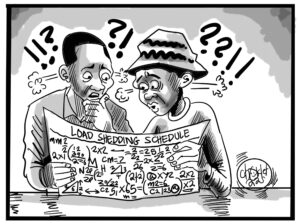Government’s huge debt servicing has resulted in little money left in circulation to meet several critical obligations, Bank of Zambia (BoZ) governor Dr Denny Kalyalya has observed.
And Dr Kalyalya has ruled out any possibility of the central bank printing more money to help government meet its statutory obligations, saying that would lead to hyper-inflation.
Meanwhile, the Central Bank has dismissed as false social media reports alleging that it recently issued K68 million and K23 million, which then disappeared.
Addressing questions from journalists during a press briefing in Lusaka, Tuesday, Dr Kalyalya observed that government’s huge debt servicing had meant that there was little money left in circulation to meet several critical obligations.
He was reacting to a question on what the key driving factors were behind Treasury Bills and government bonds being undersubscribed at recent auctions.
“I think it’s no secret that debt service has been very elevated, which means that much of the resources that we are getting are going towards meeting the debt service. And the way our system is set-up is that, debt servicing takes precedence over other obligations; this is why a lot of concern has been raised by many stakeholders as to ‘what are we doing to contain our debt?’ So, in doing that, that means there is little money remaining around,” Dr Kalyalya observed.
“You have heard the arrears also affecting the various players in the economy so it’s a circular flow. When you have payments outside, it’s what we call in economics 101 – a leakage in the system.”
He observed that there was need for government to prioritise clearing local arrears.
“That’s why the emphasis when you pay arrears, focus on the domestic players. If I don’t pay, he is affected in paying to that one and the whole chain is affected. So, this is one of the major sources of this undersubscription we have seen,” he explained.
“Also, the portfolio players are very sensitive to changing sentiments. So, like I said, they have more or less disappeared in the Treasury Bills, which have more frequency.”
Zambia’s external debt was at an unprecedented US$10.05 billion by the end of last year compared to US $8.74 billion by the end of 2017.
Debt servicing commitments equally increased to unprecedented levels of nearly US$760 million last year from around US $63 million in 2013.
The government’s arrears owed to contractors and suppliers had also grown to unprecedented levels of K15.1 billion by the end of last year, up from K14.7 billion by the end of the third quarter of 2018, Ministry of Finance data shows.
On the other hand, funds raised through government securities declined to K5.8 billion during the fourth quarter of last year from K6.4 billion during the same period in 2017, according to BoZ data.
Non-resident investor holdings of government securities also dropped to K8 billion by the end of the fourth quarter of 2018 compared to K8.4 billion during the same quarter of 2017.
And asked if printing more money was a feasible means of helping government meet its huge obligations amidst mounting salary arrears for public sector workers, Dr Kalyalya ruled out such a move on account of the hyper-inflationary effects.
“I think you have seen other countries, which went on the printing press, even us before in the past, when there was printing of money, how much was inflation? It became hyper,” Dr Kalyalya replied.
He, however, explained that government was allowed to access a limited threshold amount of up to 15 per cent of the gross revenues the BoZ earned from prior years.
“If the government wanted to get access to the (central) bank, the law provides that they can access up to 15 per cent of previous year ordinary revenue. So, you would have to compute what, for example, 2018 revenue will be and 15 per cent of that government can access provided it has not already reached that limit,” he explained.
“So, it’s not that because they have no money, they can just come and say ‘help us out’ because that is inflationary. And remember, in issuance of currency, we have to take into account the primary objective of the (central) bank, which is price and financial system stability so whatever we do must be in that context.”
Meanwhile, the central bank dismissed social media reports that it recently issued K68 million and K23 million that had disappeared.
“We have been tracking a story, which has been making rounds where it has been reported that the BoZ printed K68 million, which also vanished; and it was alleged that it was used for other business. This issue of issuing currency disappearing doesn’t happen because we follow rules that have been established,” explained Dr Kalyalya.
BoZ deputy governor for operations Dr Bwalya Ng’andu echoed Dr Kalyalya’s sentiments in dismissing the story as a total fabrication.
“Both information relating to the K23 million and K68 million is absolute and total fabrication; there is absolutely no truth to it. We need to guard ourselves against fabrications because they can undermine the integrity of institutions,” said Dr Ng’andu.




















2 responses
Great analysis news diggers please keep digging and updating citizens
Since the governor has told us that debt servicing has brought the effect of leaving little money in circulation, and that printing more money will increase inflation, we need to limit the amount of money that foreign investors sent back to their home countries. This can also assist in enhancing the circulation of money locally while avoiding inflation. This is what other countries do. Let’s not be afraid of foreign investors.